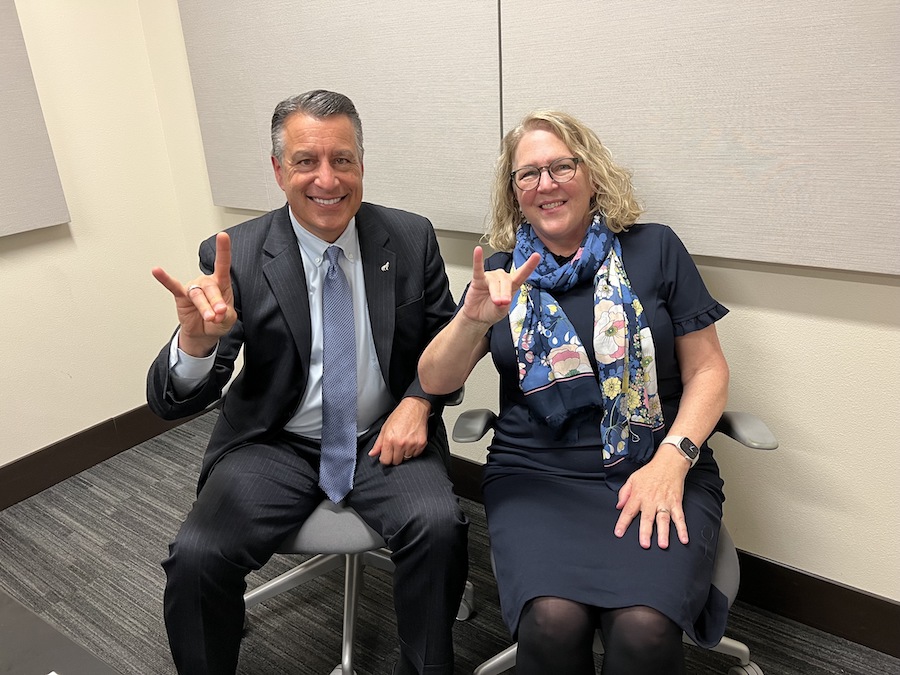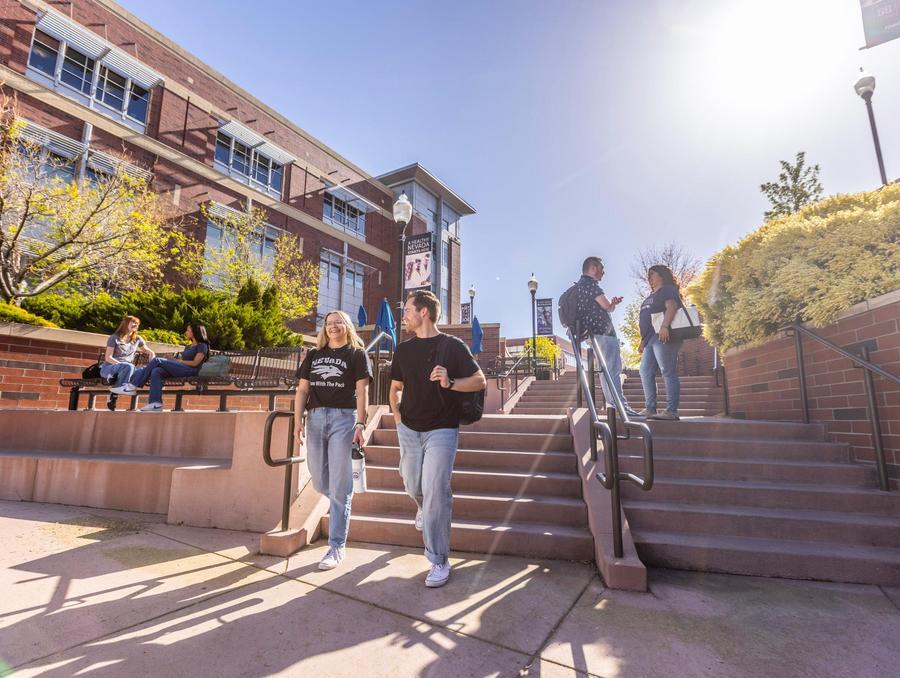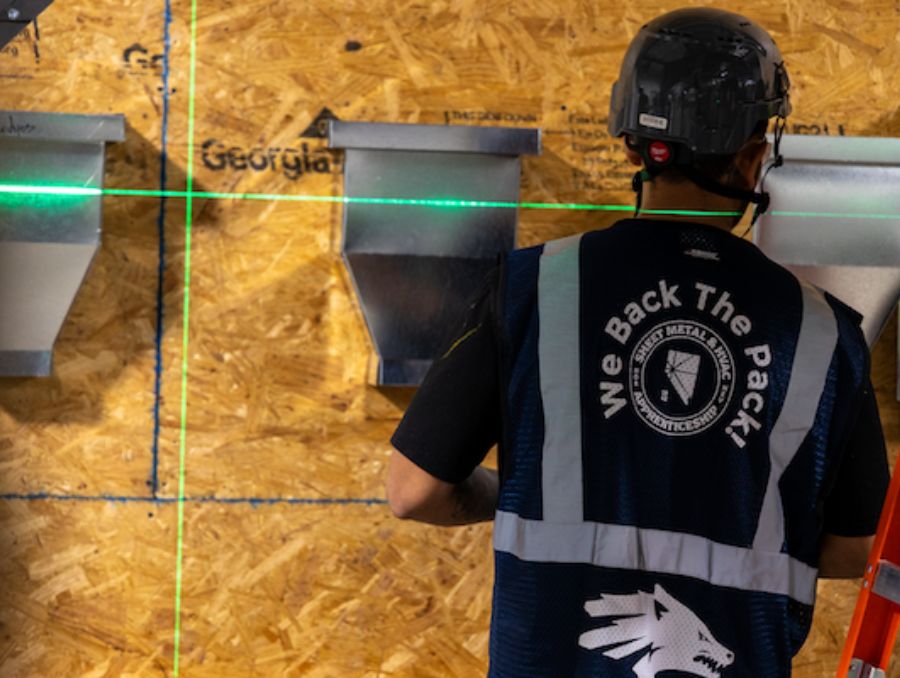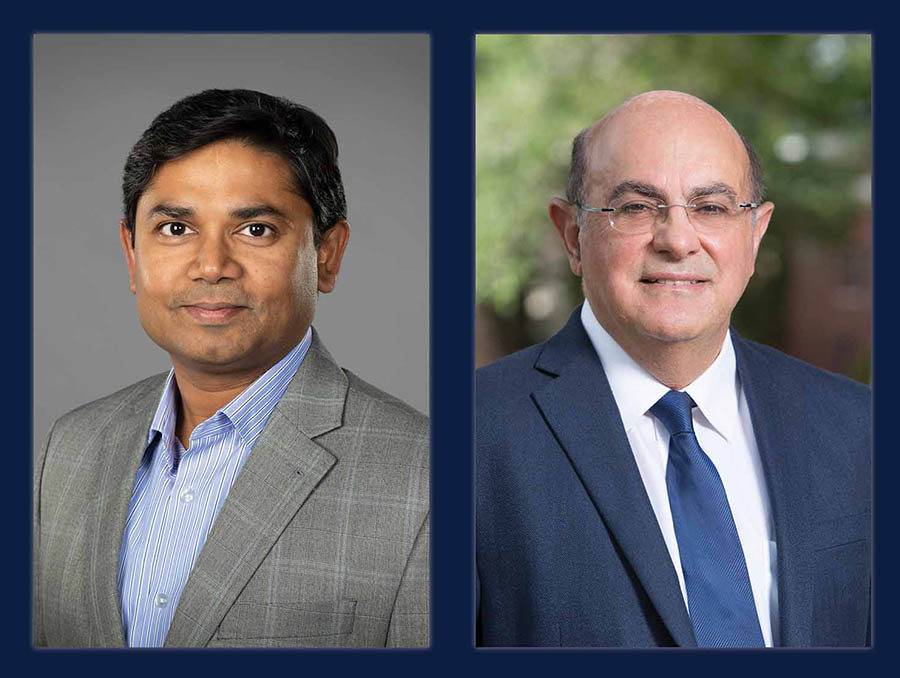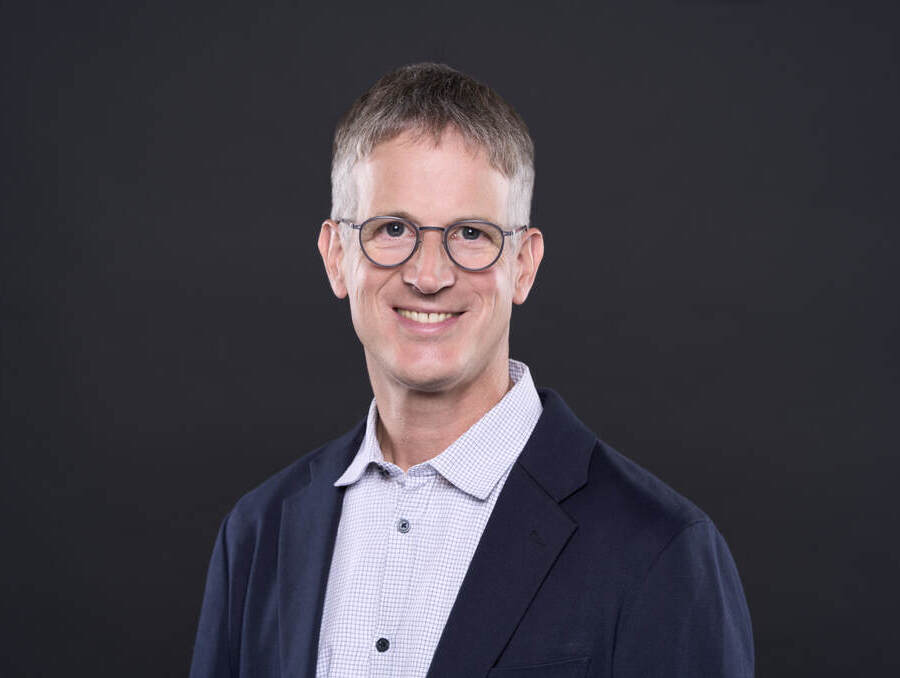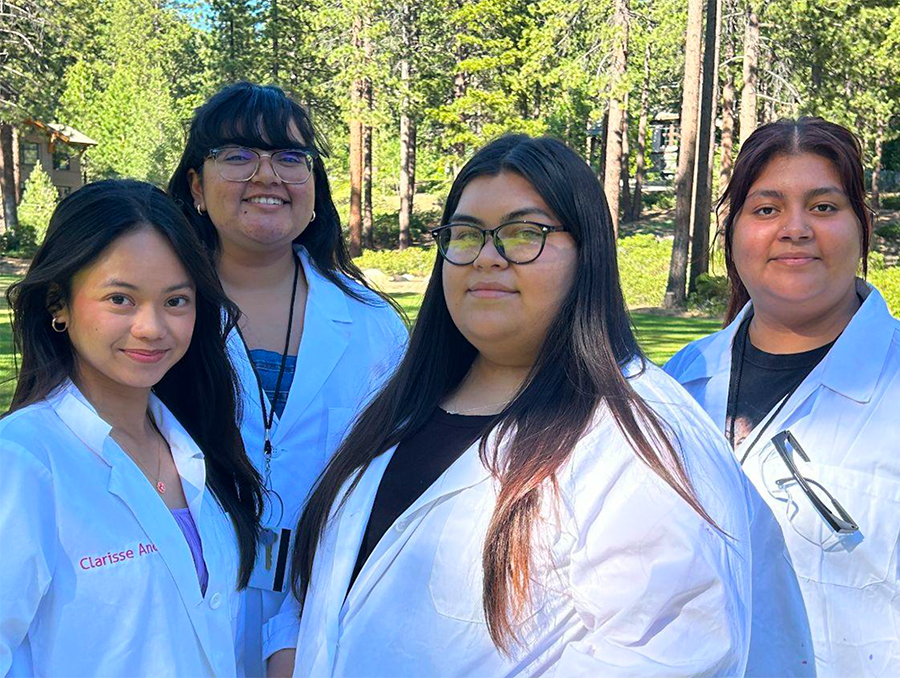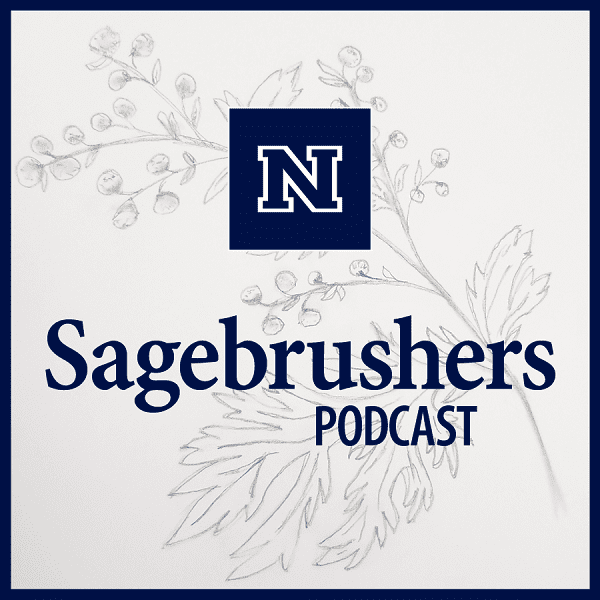
In this episode of Sagebrushers, University of Nevada, Reno President Brian Sandoval speaks with Catherine Cardwell, dean of the University Libraries for the University of Nevada, Reno.
During the episode, Sandoval and Cardwell discuss the impact of the University Libraries, the University's sesquicentennial and the archivists who are helping to bring stories to life, open educational resources, the ways in which the libraries support students and researchers at this Carnegie R1 institution, and more.
Thank you for listening to Sagebrushers. We would love to hear from you. Please take a few minutes and respond to this four-question survey to help us improve future episodes.
Sagebrushers is available on Spotify, Apple Podcasts and other major podcast platforms, with new episodes every month.
Sagebrushers – S2 Ep. 19 – Dean of University Libraries, Catherine Cardwell
Join host President Brian Sandoval as he and Dean of University Libraries Catherine Cardwell discuss the far-reaching impact of the University Libraries and the role they play in building and supporting the Wolf Pack community.
Dean Catherine Cardwell: What I try to instill in my staff is that we're a learning library ourselves, that we continue to learn, we continue to change, we continue to grow.
University President Brian Sandoval: In this episode of Sagebrushers, we welcome Catherine Cardwell, interim vice president of Student Services and dean of University Libraries at the University of Nevada, Reno. I'm Brian Sandoval. I'm a proud graduate and president of the University, and I'm your host of Sagebrushers.
Dean Catherine Cardwell joined the University Libraries in August 2021. She's the co-editor of Leading Change in Academic Libraries, a collection of change stories analyzing 20 academic libraries across the country. With previous leadership experience at several other universities, Catherine has a deep understanding of the challenges and opportunities in academic libraries in higher education. Along with her faculty and staff, she's redefining what it means to be a forward-looking research library committed to student success. Prior to joining the University, Catherine held, a dual appointment as the regional associate vice chancellor of Academic Affairs and campus dean of the Nelson Poynter Memorial Library at the University of South Florida, St. Petersburg.
Today's podcast is being recorded at the Reynolds School of Journalism on our University's campus. Dean Cardwell, welcome to Sagebrushers. I'm excited to share with our listeners some of the incredible things Libraries do for our Wolf Pack family.
Cardwell: Well, thank you, President Sandoval. I'm happy to be here.
Sandoval: No, we're thrilled. We are absolutely thrilled. So, before we dive into the impact of the Libraries, I'd like to hear a little more about your background and how it has helped to shape the new vision you have for University Libraries.
Cardwell: Well, thank you. And like you, I am a proud liberal arts graduate. I have degrees in English and French and a master's in French. And I think that what drew me to the liberal arts was just a love of learning. Learning about the world, exposure, and I think I've stayed in higher education my whole career because I think that education opens doors to opportunities and opens doors to the world. It did so for me. I had a wonderful undergraduate experience with faculty who invested a lot in me, and I really try to provide that experience for the students at our institution. And at the same time, I think working in all these in various places, I've seen that there's not one way to do things. There's not one way to be a library. There's not one way to get things accomplished. And I think because of that I tend to be very open to change and willing to try new things.
And I really try to instill that in my staff. And I would say with what I'm trying to do with the Libraries, we are an R1 institution. We are very committed to student success, which are strong competing interests sometimes, but we have to embrace both. And I would say that the Libraries and what I try to instill in my staff is that we're a learning library ourselves, that we continue to learn, we continue to change, we continue to grow, and that affects how we interact with students and affects how we interact with faculty conducting high-impact research.
Sandoval: So you're in your third year at the University, I guess the beginning of your third year. Will you talk a little bit about what attracted you to coming to the University of Nevada and what your experience has been since you got here?
Cardwell: Well, I was really attracted to the University for a variety of reasons. One was its commitment to education, its commitment to research. And then when I came for my interview, I grew up in Ohio, spent most of my life there and I spent some time in Florida. But when I came on campus, I was just floored by how beautiful it was. The quad, the buildings, just the environment, the natural surroundings. It was just a wonderful opportunity. And I interviewed here. I really was taken by the faculty and staff in the Libraries, taken by the campus administration and your leadership. Also, when I talk about that, I grew up in Ohio, I grew up in Youngstown, which is a particular spot. It has a history of being very gritty and very tough. And I see kind of that fight in UNR that ‘we're going to do better. We're going to grow, we're going to have an impact.’ And I see that we're always fighting for better. That was something that really impacted me when I decided to come here
Sandoval: And thank you. And I like to say we punch way above our weight.
Cardwell: Exactly.
Sandoval: No, really proud of the people. And you've done incredible things. So, as we know, the University is currently celebrating the sesquicentennial anniversary. The Libraries have been instrumental in helping to tell the stories in our extensive history. What has that effort been like and have there been any surprises you've come across?
Cardwell: Well, it has been an incredible opportunity to be a part of the celebration. The Libraries’ faculty and staff have really risen to the occasion. I was thinking the other day that I wanted to take a picture of all the people who have worked on the sesquicentennial and really it would have to be everyone who works in the Libraries. Everyone has touched it in some ways. We have a standing committee made up of representatives from around the Libraries. We meet every other Friday and we work on, plan, for the future. We figure out what displays are going up. We figure out where we're going to be putting decorations. We have displays that are going to be rotating. Right now we have several displays on the third floor, more traditional archival displays, that show the building of the University, the history, the founding. On the first floor we have an interactive timeline that people can use to jump around and see the timeline of the University. We also have a "traditions" display. Those are going to be changing two more times each. So, people will continue to get a sense of their rich history. And the folks in @One have put together also, we have a large monitor, a reel of historical movies related to the University graduations, promotional materials ... it's really fascinating to watch.
Sandoval: No, and I love history, as you know. And there's that display right now that speaking of films, that there have been many films that have been produced on this campus. Can you talk a little bit about that?
Cardwell: Yes. There's been a series of films that we wanted to highlight that we're actually, our campus looks like an East Coast, red brick university. And so a lot of the films in the forties were filled here. "Mr. Belvedere Goes to College," is one that I can think of. And so it was a really great movie set. And the University features prominently in several movies. I do believe there's going to be a movie night at some point where students can come and watch and see the historical movies and just get a sense of what the campus looked like at that point.
Sandoval: Oh, Shirley Temple, Mickey Rooney, there's been some, quite the celebrities that have been on campus.
Cardwell: And, interestingly enough in the reel that @One put together, there are promotional videos made by people like John Davidson, Sammy Davis Jr., who featured, who were promoting the University. So not a movie, but people who were on in Reno supporting the campus, which is also very interesting.
Sandoval: And I have to say "Mr. Belvedere Goes to College" is one of my personal favorites. It's a fun movie that you can actually rent on Apple TV for like $3. So, if you want to see a great film about the campus way back in 1940s, it's really wonderful.
Cardwell: And you also asked about surprises that I've had. I'm not an archivist, I'm not a historian, but I think I continue to be fascinated by Hannah Clapp, who was one of the first faculty members at the University. Close to my heart, she was a librarian, but she also had a broad understanding of education and the importance of plays in people's lives. And in particular, I thought it was really interesting because just the other day I was reading Doten's history about the University, and he was talking a lot about the beginnings of the state and how difficult it was to get educational systems established because the people who came here were not settlers, they were minors. So, you weren't really getting a large number of families coming.
There weren't a lot of women, weren't a lot of children. So, it was a slow start to get education going. And then Hannah was a person who came and she started a school before coming to the University. And also the little-known fact that she was also a businessperson who bid to put the iron railing around a building in Carson City. And she and her partner who made the investment walked away with about a thousand dollars at the time. And people were really amazed. They couldn't believe that two women did that. And so I think that spirit, that love of knowledge and that willingness and drive to go into new areas was something that was really prominent in her life.
Sandoval: No, and she's a remarkable individual and that, she's one of those people that cannot get lost to history. And so I'm really grateful that you focused on her. So, some folks may not realize the extent of University Libraries. You manage three locations and many departments within those locations. Can you help paint a picture for those who may not be aware of just how far-reaching the Libraries are and the various populations that are served?
Cardwell: So, the University supports the entire University and its mission, which means students, faculty, staff and the community. So, we support all of the University's mission. We have three locations: The Knowledge Center, the DeLaMare Science and Engineering Library, and most recently, Prim Library. KC is what we would call our central library. It is one of the most technologically innovative libraries in the country. We have access to technology and resources that many other academic libraries, R1 libraries, dream of because of its history of its connection to technology. The DeLaMare Library, the Science and Engineering Library, is in the historical Mackay building. And it feels like a historical building. It has that sense of history, that feeling. It's really been preserved, but at the same time, it's also home to our makerspace, which has incredible equipment, incredible services that can help students learn about different pieces of technology, different pieces of equipment that can help them make things. And we have things from sewing machines and embroidery machines to 3D printers and all kinds of equipment that people can, circuitry students, can use to work on their class projects.
Prim Library is really, it's on the Lake Tahoe campus. It is probably, we are lucky to be one of the only units on campus to have a physical presence there. We have with the library, we have a collection related to fine arts, creative writing and the environment. And so that's kind of the focus of that Library. And we are trying to build a lot of connections with people in the community in that Library so they start to see the campus as something that they're welcome on and can be part of.
Sandoval: No, and with regard to the KC, the Knowledge Center, we have MARS. We can't not talk about MARS.
Cardwell: So, MARS is an automated retrieval system. So, one of the things that was a real trend in libraries, especially in the early 2000’s, was that students wanted to come to the libraries and use the space for collaborative work, studying. And with that space, we had to make a decision about what to do with the collection, the books. And so a lot of libraries are putting things in retrieval systems or depositories. A lot of libraries have them offsite, but ours is actually built into the building, into the ground. And so we have a lot of books that, we have books on the fourth and fifth floor, but to open up spaces for other services, we have used that automated retrieval system. And you need a book. It's in the automated retrieval system. You request it, the retrieval system goes and grabs it. And it's a big robot that goes down and gets the book and brings it back. It is, it's not in order by call number or subject. It's just in order by bins. And so the way it comes in or goes out is how it's put back in. And the robot can find it because of the bin number. So, the robot knows location of that bin number can go grab it.
Sandoval: It's hard to describe. It's massive. I mean, it's 10 stories high and probably a football field wide. And you see this robot go down this narrow area and then shoots up and then grabs the bin and brings it back. And it's like Harry Potter. It is. It's really amazing. And just really briefly, that Prim Library is considered one of the most beautiful libraries in the United States.
Cardwell: Yes, yes. And it was on the cover of one of our library journals when it was built. And it did win a regional architectural award. And it, it's heated by thermal energy coming from the ground, not from a more traditional kind of heating system, but it is beautiful. It looks out onto the campus. It's just got a really nice feel to it.
Sandoval: So, you mentioned earlier about Open Educational Resources, and that project really excites me as it makes learning more accessible and affordable to many. Can you talk a little more about what those are, and why they matter and what they mean?
Cardwell: Well, the textbook industry has really, the cost of textbooks has increased so much over the course of the past 20 years. In fact, cost of textbook has grown multiple times the cost of inflation. And it's just really become a burden. And textbook publishers have found ways to keep getting students to spend money on them and to keep earning money, whether it's through course IDs that go into the textbooks for online access, you can't give your online access code to somebody else. So, the whole industry is built around profit for them. We are taking part in a movement called Open Educational Resources where we're working with faculty so that they can provide low-cost or no-cost resources to the students. A lot of faculty have created OERs around the country. We have some faculty here who've used OERs. And so essentially this reduces the cost of going to school for students.
And the other issue I would say that is a big issue is that students have access to their course materials the first day of class. And back when I was a reference librarian and I worked at the reference desk, I can tell you that there were so many students who would try to get their textbooks through the libraries, and we just didn't have them. We didn't have the budget to do something like that, and they would be on the verge of tears because they couldn't get their textbooks. So, this removes that barrier for those students and they have access to it. And researchers, researchers have found that students who have access to materials on the first day do much better in their courses. And so we actually, we have a team in the Library who's been working on it with the provost office and the Office of Digital Learning. And now with Carley Ries beginning, we are trying to start a pilot of one faculty, create an online class, we're going to figure out a way to incentivize faculty to create an OER or adopt an OER to keep the cost of education lower.
Sandoval: And then that works hand in hand with the Digital Wolf Pack Initiative, which is, for the listeners, every incoming freshmen and transfer student receives an Apple iPad Air. So, they can provide those OERs, the Open Educational Resources, right onto their Apple iPad. So, that's wonderful. So, we're almost out of time. So, can you share some of the exciting things that the Libraries have planned in the coming year?
Cardwell: Well, we've finished our own strategic plan that supports the Wolf Pack Rising, and last year we became a member of an organization called the Greater Western Library Alliance. And to support the University's efforts to become an AAU institution, we are positioning ourselves to become a member of the Association of Research Libraries or an ARL library. And almost all of the AAU institutions except for four, are ARL members. So, this, to be a member of ARL, you have to have a certain level of resources. You have to have unique special collections, and it's not just about having those collections. You have to show that researchers are using your special collections and your unique collections. And we have the Basque Library, we have researchers who are using that quite a lot. And for example, recently we are working with two other institutions, Idaho State University, and another institution where we are going out and making visual artificial reality versions of arborglyphs or tree carvings. So we are both preserving the arborglyphs, but also researchers are using them to conduct research on the Basque immigration to the United States.
Sandoval: Well, thank you. And that's fascinating. And unfortunately, that is all the time we have for this episode of Sagebrushers. Thank you for joining us, Dean Cardwell. It's been a fascinating conversation
Cardwell: And thank you President Sandoval.
Sandoval: So, join us next time for another episode of Sagebrushers as we continue to tell the stories that make our University special and unique. Until then, I'm University President Brian Sandoval and go pack.
